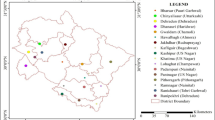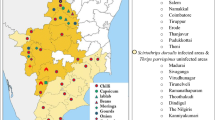Abstract
Thrips are economically important pests of crops and vectors of viral diseases worldwide. Invasion and outbreak of thrips have recently caused havoc in agricultural and horticultural ecosystems in India. Species identification is challenging due to their small size and subtle morphological differences. The present morphological and molecular studies revealed that, the thrips species which had created havoc on chilli at Andhra Pradesh and Telangana states of India during 2021–22 was an invasive thrips, Thrips parvispinus (Karny). The mean population of thrips ranged from 18.46 to 37.16 per five terminal leaves across the surveyed chilli fields. The most affected fields were noticed in Guntur district of Andhra Pradesh followed by Bhadradri Kothagudem district of Telangana with > 75 per cent foliage showing curling symptoms due to thrips feeding at both the locations. Genomic sequence variation in terms of haplotype diversity and nucleotide complexity was observed among 51 T. parvispinus GenBank accessions from India and Indonesia using mtCOI as molecular marker. A total of 12 haplotypes were identified from the 51 sequences of T. parvispinus. Nucleotide diversity of the Indian sequences as observed to be higher (π = 0.00585) than that of Indonesia (π = 0.00396). Similarly, haplotype diversity was also observed to be maximum in Indian accessions (Hd = 0.856) compared to Indonesia (Hd = 0.580). The genetic diversity and demography of T. parvispinus from India revealed the populations from India having more haplotype diversity than populations from Indonesia with a weak genetic structure observed between the populations among India and Indonesia. The shared haplotype H8 between Indonesia and India assumes a flow of genetic material, and implies Indonesia could be a plausible source of T. parvispinus invasion into India.



Similar content being viewed by others
References
Ananthakrishnan, T. N., & Sen, S. (1980). Taxonomy of Indian Thysanoptera. Handbook Series No.1, Zoological Survey of India, Kolkata, 234.
Ananthakrishnan, T. N., & Dhileepan, K. (1984). Thrips-fungus association with special reference to the sporophagous Bactrothrips idolomorphus (Karny) (Tubulifera: Thysanoptera). Proceedings of the Indian Academy of Sciences Animal Sciences, 93(3), 243–249.
Ashokan, R., Kumar, N. K., Kumar, V., & Ranganath, H. R. (2007). Molecular differences in the mitochondrial cytochrome oxidase I (mtCOI) gene and development of a species-specific marker for onion thrips, Thrips tabaci Lindeman, and melon thrips, T. palmi Karny (Thysanoptera: Thripidae), vectors of tospoviruses (Bunyaviridae). Bulletin of Entomological Research, 97(5), 461–470.
Ball, S. L., & Armstrong, K. F. (2006). DNA barcodes for insect pest identification: A test case with tussock moths (Lepidoptera: Lymantriidae). Canadian Journal of Forest Research, 36(2), 337–350.
Banerjee, D., Kumar, V., Maity, A., Ghosh, B., Tyagi, K., Singha, D., Kundu, S., Laskar, B. A., Naskar, A., & Rath, S. (2015). Identification through DNA barcoding of Tabanidae (Diptera) vectors of surra disease in India. Acta Tropica, 150, 52–58.
Basavaraj, K., Sreenivas, A. G., Prasad, P. B., & Rachana, R. R. (2022). First report of invasive thrips, Thrips Parvispinus (Karny) (Thysanoptera: Thripidae) infesting chilli, Capsicum annuum L. in Kalaburagi, Karnataka, India. Journal of Experimental Zoology India, 25(1), 191–194.
Bhatti, J. S. (1999). Enigmatic complete anterior tentorium and tentorial body in adults of the Onion thrips, Thrips tabaci (Thripidae), with review of the tentorium in the Order Terebrantia. Thrips, 1, 15–30.
Buckman, R. S., Mound, L. A., & Whiting, M. F. (2013). Phylogeny of thrips (Insecta: Thysanoptera) based on five molecular loci. Systematic Entomology, 38(1), 123–133.
Dickey, A. M., Kumar, V., Hoddle, M. S., Funderburk, J. E., Morgan, J. K., Jara-Cavieres, A., Shatters, R. G. J., Osborne, L. S., McKenzie, C. L. (2015). The Scirtothrips dorsalis species complex: endemism and invasion in a global pest. PLoS One, 10(4).
Excoffier, L., & Lischer, H. E. (2010). Arlequin suite ver. 3.5: a new series of programs to perform population genetics analyses under Linux and Windows. Molecular Ecology Resources, 10(3), 564–567.
Felsenstein, J. (1985). Confidence limits on phylogenies: An approach using the bootstrap. Evolution, 39, 783–791.
Folmer, O., Black, M., Hoeh, W., Lutz, R., & Vrijenhoek, R. (1994a). DNA primers for amplification of mitochondrial cytochrome c oxidase subunit I from diverse metazoan invertebrates. Molecular Marine Biology and Biotechnology, 3(5), 294–299.
Folmer, O., Hoeh, W. R., Black, M. B., & Vrijenhoek, R. C. (1994b). Conserved primers for PCR amplification of mitochondrial DNA from different invertebrate phyla. Molecular Marine Biology and Biotechnology, 3(5), 294–299.
Fu, Y. X., & Li, W. H. (1993). Statistical tests of neutrality of mutations. Genetics, 133(3), 693–709.
Grant, W. A. S., & Bowen, B. W. (1998). Shallow population histories in deep evolutionary lineages of marine fishes: Insights from sardines and anchovies and lessons for conservation. Journal of Heredity, 89(5), 415–426.
Hebert, P. D., Cywinska, A., Ball, S. L., & DeWaard, J. R. (2003). Biological identifications through DNA barcodes. Proceedings of the Royal Society of London Series b: Biological Sciences, 270(1512), 313–321.
Hebert, P. D., Penton, E. H., Burns, J. M., Janzen, D. H., & Hallwachs, W. (2004). Ten species in one: DNA barcoding reveals cryptic species in the neotropical skipper butterfly Astraptes fulgerator. Proceedings of the National Academy of Sciences, 101(41), 14812–14817.
Iftikhar, R., Ashfaq, M., Rasool, A., Hebert, P.D. (2016). DNA barcode analysis of thrips (Thysanoptera) diversity in Pakistan reveals cryptic species complexes. PLoS One, 11(1).
Kaur, S., Dhaliwal, M. S., Cheema, D. S., & Sharma, A. (2010). Screening of chilli germplasm for resistance against chilli thrips and yellow mite. Journal of Research Punjab Agricultural University, 47(3), 143–144.
Kimura, M. (1980). A simple method for estimating evolutionary rates of base substitutions through comparative studies of nucleotide sequences. Journal of Molecular Evolution, 16(2), 111–120.
Kumar, V., Seal, D. R., Osborne, L. S., & McKenzie, C. L. (2014). Coupling scanning electron microscopy with DNA bar coding: A novel approach for thrips identification. Applied Entomology and Zoology, 49(3), 403–409.
Kumar, S., Stecher, G., Li, M., Knyaz, C., Tamura, K. (2018). MEGA X: Molecular evolutionary genetics analysis across computing platforms. Molecular Biology and Evolution, 35(6).
Lee, D. K., In, J., & Lee, S. (2015). Standard deviation and standard error of the mean. Korean Journal of Anesthesiology, 68(3), 220–223.
Lee, Y., Lee, W., Kanturski, M., Foottit, R. G., Akimoto, S. I., & Lee, S. (2017). Cryptic diversity of the subfamily Calaphidinae (Hemiptera: Aphididae) revealed by comprehensive DNA barcoding. PLoS ONE, 12(4), e0176582.
Librado, P., & Rozas, J. (2009). DnaSP v5: Software for comprehensive analysis of DNA polymorphism data. Bioinformatics Applications Note, 25(11), 1451–1452.
Mound, L. A., & Azidah, A. A. (2009). Species of the genus Thrips (Thysanoptera) from Peninsular Malaysia, with a checklist of recorded Thripidae. Zootaxa, 2023(1), 55–68.
Mound, L. A., & Collins, D. W. (2000). A South East Asian pest species newly recorded from Europe: Thrips parvispinus (Thysanoptera: Thripidae), its confused identity and potential quarantine significance. European Journal of Entomology, 97, 197–200.
Mound, L. A., & Marullo, R. (1996). The Thrips of Central and South America: An introduction. Memoirs on Entomology International, 6, 1–488.
Mound, L. A., & Masumoto, M. (2005). The genus Thrips (Thysanoptera, Thripidae) in Australia, New Caledonia and New Zealand. Zootaxa, 1020(1), 1–64.
MsangoSoko, K., Gandotra, S., Chandel, R. K., Sharma, K., Ramakrishinan, B., & Subramanian, S. (2020). Composition and diversity of gut bacteria associated with the eri silk moth, Samia ricini, (Lepidoptera: Saturniidae) as revealed by culture-dependent and metagenomics analysis. Journal of Microbiology and Biotechnology, 30(9), 1367–1378.
Murai, T., Watanabe, H., Toriumi, W., Adati, T., & Okajima, S. (2009). Damage to vegetable crops by Thrips parvispinus Karny (Thysanoptera: Thripidae) and preliminary studies on biology and control. Journal of Insect Science, 10, 166.
Perring, T. M. (2001). The Bemisia tabaci species complex. Crop Protection, 20(9), 725–737.
Rachana, R. R., Roselin, P., & Varatharajan, R. (2018). Report of invasive thrips species, Thrips parvispinus (Karny) (Thripidae: Thysanoptera) on Dahlia rosea (Asteraceae) in Karnataka. Pest Management in Horticultural Ecosystems, 24(2), 175–176.
Rachana, R. R., Roselin, P., Amutha, M., Sireesha, K., & Reddy, G. N. (2022). Invasive pest, Thrips parvispinus (Karny) (Thysanoptera: Thripidae) - a looming threat to Indian agriculture. Current Science, 122(2), 211–213.
Riley, D. G., Joseph, S. V., Srinivasan, R., & Diffie, S. (2011). Thrips vectors of tospoviruses. Journal of Integrated Pest Management, 2(1), 1–10.
Roderick, G. K. (2004). Tracing the origin of pests and natural enemies: genetic and statistical approaches. In: Lester EE, Sforza R, Mateille T (Eds.), Genetics, evolution and biological control CABI Cambridge (pp. 97–112).
Roselin, P., Sharma, K., & Rachana, R. R. (2021). Diversity of floral thrips from Western Ghats of Karnataka. Indian Journal of Entomology, 83(3), 407–410.
Rugman-Jones, P. F., Hoddle, M. S., Mound, L. A., & Stouthamer, R. (2006). Molecular identification key for pest species of Scirtothrips (Thysanoptera: Thripidae). Journal of Economic Entomology, 99(5), 1813–1819.
Rugman-Jones, P. F., Hoddle, M. S., & Stouthamer, R. (2010). Nuclear-mitochondrial barcoding exposes the global pest western flower thrips (Thysanoptera: Thripidae) as two sympatric cryptic species in its native California. Journal of Economic Entomology, 103(3), 877–886.
Shao, R., & Barker, S. C. (2003). The highly rearranged mitochondrial genome of the plague thrips, Thrips imaginis (Insecta: Thysanoptera): convergence of two novel gene boundaries and an extraordinary arrangement of rRNA genes. Molecular Biology and Evolution, 20(3).
Sireesha, K., Prasanna, B. V. L., Vijaya Lakshmi, T., & Reddy, R. V. S. K. (2021). Outbreak of invasive thrips species Thrips parvispinus in chilli growing areas of Andhra Pradesh. Insect Environment, 24(4), 514–519.
Sridhar, V., Chandana, P. S., & Rachana, R. (2021). Global status of Thrips Parvispinus (Karny, 1922), an invasive pest. The Journal of Research PJTSAU, 49(4), 1–11.
Tajima, F. (1989). Statistical method for testing the neutral mutation hypothesis by DNA polymorphism. Genetics, 123(3), 585–595.
ThripsWiki (2022). ThripsWiki - providing information on the World's thrips.
Toda, S., & Murai, T. (2007). Phylogenetic analysis based on mitochondrial COI gene sequences in Thrips tabaci Lindeman (Thysanoptera: Thripidae) in relation to reproductive forms and geographic distribution. Applied Entomology and Zoology, 42(2), 309–316.
Tyagi, K., Kumar, V., Singha, D., & Chakraborty, R. (2015). Morphological and DNA barcoding evidence for invasive pest thrips, Thrips parvispinus (Thripidae: Thysanoptera), newly recorded from India. Journal of Insect Science, 15(1), 10.
Tyagi, K., Kumar, V., Singha, D., Chandra, K., Laskar, B. A., Kundu, S., Chakraborty, R., & Chatterjee, S. (2017). DNA Barcoding studies on Thrips in India: Cryptic species and Species complexes. Scientific Reports, 7(1), 1–14.
Acknowledgements
We thank the officials of Directorate of Plant Protection Quarantine and Storage, Government of India; Andhra Pradesh State Department of Horticulture; Telangana State Department of Horticulture and chilli growing farmers of Andhra Pradesh and Telangana states for their arrangements and assistance during the field survey. We also thank Assistant Director General (Plant Protection & Biosafety), Indian Council of Agricultural Research for his constant guidance and support in carrying out the present investigation.
Author information
Authors and Affiliations
Contributions
All authors contributed to the study. Kerur Vishwanath Raghavendra, Rajan Remani Rachana, Kurubarahalli Bhoothanna Ramesh, Chowdanayak Mahendra: conceptualization, formal analysis and scientific investigation, original draft preparation. Kerur Vishwanath Raghavendra, Subhash Chander, Surender Kumar Singh, Kurubarahalli Bhoothanna Ramesh: critically edited the manuscript. All authors read and approved the final manuscript.
Corresponding authors
Ethics declarations
Competing interest
All the authors declare that they have no known competing financial interest or personal relationship that could have appeared to influence the work reported in this paper.
Conflict of interest
The authors declare that they have no conflict of interest.
Additional information
Publisher's note
Springer Nature remains neutral with regard to jurisdictional claims in published maps and institutional affiliations.
Supplementary Information
Below is the link to the electronic supplementary material.
Rights and permissions
Springer Nature or its licensor (e.g. a society or other partner) holds exclusive rights to this article under a publishing agreement with the author(s) or other rightsholder(s); author self-archiving of the accepted manuscript version of this article is solely governed by the terms of such publishing agreement and applicable law.
About this article
Cite this article
Raghavendra, K.V., Ramesh, K.B., Rachana, R.R. et al. Genetic diversity analysis of severely infesting invasive thrips, Thrips parvispinus (Karny) in chilli (Capsicum annuum L.) in India. Phytoparasitica 51, 227–239 (2023). https://doi.org/10.1007/s12600-023-01054-1
Received:
Accepted:
Published:
Issue Date:
DOI: https://doi.org/10.1007/s12600-023-01054-1




